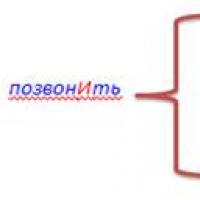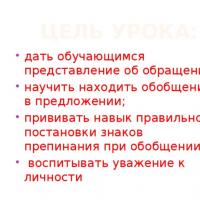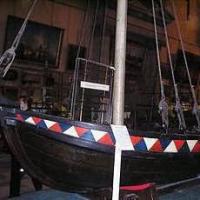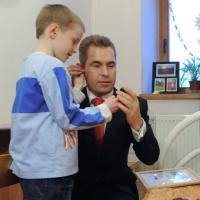If so, how? What character types do you know? Is it possible to change your character? Theorem on the equilibrium of three non-parallel forces
There are four types of characters in total:
1) choleric;
2) sanguine;
3) phlegmatic;
4) melancholic.
They are rarely found in their pure form. Most often it is a combination of two types of traits. For example, a choleric-sanguine person. Of course, they can only be combined in a certain way. A choleric person cannot be melancholic at the same time.
Changing your character is very difficult. There are various techniques. Achieving results is only possible if a person really wants it and makes every effort. For example, a person with an explosive character wants to be calmer. He will need to control his emotions very strongly and not allow himself to relax. You need to find a channel where to channel your anger.
Consider known character types, as well as whether character can be changed and how.
Character types
The following types of people can be distinguished:
- sanguine people - characterized by cheerfulness and mobility;
- choleric people - manifested by hysteria and hot temper;
- melancholic - expressed by sadness and timidity;
- phlegmatic - reflected by calmness and slowness.
Even in ancient times, doctors such as Hippocrates knew about the types of character and their manifestations. They studied this issue and came to the conclusion that all types of behavior are inherent in humans, only in different proportions. And the dominant type of character was assigned to the person as the main one.
In other words, a sanguine person radiates joy most of the time and is unusually active. But he can also exhibit a different pattern of behavior - one prone to other types. The difference is that the vast majority of the time he is emotionally in the sanguine group. Similar behavior is observed in other types of people.
Is it possible to change character
Even in ancient times, scientists searched for the reasons for differences in human behavior. Hippocrates suggested that dominant behavior is caused by the predominance of certain chemicals in the human blood.
For example, the predominance of lymph slows down a person’s activity, which automatically imposes a phlegmatic model of behavior on him. Cholerics and melancholics have an excess of a certain composition of bile, and sanguine people have an excess of blood, as such.
Knowing causes and consequences, you can influence a person’s character. The easiest way is to change your diet or lifestyle. For example, the predominance of spicy food on the Italian menu makes them more hot-tempered and impulsive. Sicilian Italians are famous for their particular temperament, since Sicilian cuisine contains a lot of food that affects bile.
Exercising and an active lifestyle increases health and the amount of blood in the muscles and body. A person becomes more cheerful and active - becomes sanguine.
It is worth noting that this approach relies on instinctive behavior, and actors, for example, can change their character and behavior pattern based on reason.
AXIOMS OF STATICS: I If 2 forces act on a body, the body can maintain a state of rest, if the forces = modulo, act along one straight line in opposite directions
II The action of a given force on the body does not change if + to it or – from it a balanced system of forces.
Corollary from 1 and 2 aks: Without changing the action of this force on the body of application, it can be transferred along the line of action anywhere.
III If a material body is acted upon by 2 forces applied at one point, they have a resultant, represented by the diagonal of a parallelogram, plotted on the forces as on the sides.
IV Every action of one body on another causes a reaction in magnitude, but opposite in direction.
Main tasks of statics:
1. Reducing this system of forces to its simplest form.
2. Establishment of equilibrium conditions for a given system of forces.
2. Connections and their reactions.
CONNECTION. REACTIONS OF CONNECTIONS. Free called a body not connected to other bodies, from a given position any movement in space can be given. Unfree – a body whose movement in space is impeded by other bodies.
Main types of connections.
1 Smooth surface, flat. The complete reaction is always directed along the normal to the contacting surfaces.
2 Articulating support. The complete reaction is always directed normal to the surface along which the rollers move. 1 connection – vert; 2 st st – rotate + mount;
3 Pivotally fixed support. 1 connection – vert+hor; 1 st st – rotate
RULE: The complete reaction is randomly located in a plane. It must be decomposed into vertical and horizontal components.
4 Hard pinching. 3 connections.
Kernel. The total reaction in the rod is always directed along the axis of the rod.
3. How to determine the resultant of converging forces?
Constructing a parallelogram
the resultant of two forces applied to one point is applied at this point and is equal to the diagonal of a parallelogram constructed on these forces
Power triangle.
The direction of the resultant force R along the contour of the force triangle is opposite to the direction of traversing the triangle contour, determined by the summed forces

4. Theorem on the equilibrium of three non-parallel forces.
If a rigid body is in equilibrium under the action of three non-parallel forces lying in the same plane, then the lines of action of these forces intersect at one point.
5. Couple of forces. Its characteristics.
A pair of forces is a system of two forces equal in magnitude, parallel and directed in opposite directions, acting on an absolutely rigid body.
The plane of action of a pair is a plane passing through the lines of action of a pair of forces.
Leverage of a pair - the distances between the lines of action of a pair of forces. The moment of a couple of forces is called a vector m (or M) whose modulus is equal to the product of the modulus of one of the forces of the couple by its shoulder and which is directed perpendicular to the plane of action of the couple in the direction from which the couple is visible, tending to turn the body counterclockwise.
6.Is it possible to balance a pair of forces? If yes, then how?
It’s not possible, because a pair of forces has no resultants. And they are not directed in one straight line.
7. Vector and analytical expression for the moment of force relative to a point.
Moment of a force relative to a point in space
define as a vector quantity in the form of a vector product ![]() , Where -
radius vector drawn from point to point of application of force
, Where -
radius vector drawn from point to point of application of force
8.How to determine the moment of force about an axis?
The moment of a force relative to an axis is called a scalar quantity equal to the moment of projection of this force onto a plane perpendicular to the axis taken relative to the point of intersection of the axis with the plane. Mz(F)=mz(F xy)=m0(Fx,y)=+-Fxyh
9.Can the force be transferred parallel to itself? If yes, then how?
Force F can be transferred from its point without changing its action on a rigid body
application A to any center of reduction O, applying to the body with a moment M geometrically equal to M 0 this force relative to the center of reduction.
10. Conditions for equilibrium of various systems of forces.
Conditions for the equilibrium of an arbitrary system of forces in space. Necessary and sufficient conditions for the equilibrium of an arbitrary spatial system of forces applied to a rigid body are the vanishing of its main vector and the main moment relative to any point in space
The equilibrium conditions for an arbitrary spatial system of forces can be expressed in geometric form: the polygons of forces and moments of these forces must be closed.
Thus, an arbitrary system of forces located in one plane is balanced only in the case when the algebraic sums of the projections of all forces onto two coordinate axes (Ox and Oy) and algebraic sum moments of forces relative to an arbitrary point of this plane are equal to zero
For a system of parallel forces to be in equilibrium in space, it is necessary and sufficient that the algebraic sum of the projections of forces on the axis parallel to them is equal to zero and the algebraic sum of the moments of forces relative to the other two coordinate axes is equal to zero
for the equilibrium of parallel forces located in the same plane, it is necessary and sufficient that the algebraic sum of the projections of the forces onto the axis parallel to them and the algebraic sum of the moments of these forces relative to an arbitrary point are equal to zero
VII. Issuance and replacement of driver's licenses to persons
Decree of the Government of the Russian Federation of December 15, 1999 N 1396
(as amended on 02/14/2009, as amended on 04/11/2013)
"On approval of the Rules for passing qualification exams and issuing driver's licenses"
VIII. Issuance and replacement of driver's licenses
certificates for persons temporarily staying
in the territory Russian Federation
(as amended by Decree of the Government of the Russian Federation of November 21, 2001 N 808)
44. In the Russian Federation, persons temporarily staying on its territory have the right to drive vehicles if they have an international or foreign national driver's license that meets the requirements of the 1968 Convention on Road Traffic, the entries in which are made or duplicated in letters of the Latin alphabet.
Foreign national driver's licenses that do not meet the requirements of this Convention must have a duly certified translation into Russian.
Driver's licenses with the distinctive sign "SU" (USSR) issued in the republics of the former USSR are also considered foreign national driver's licenses.
When driving vehicles, these persons may have Russian driver's licenses obtained in the manner prescribed by these Rules.
45. Persons temporarily staying on the territory of the Russian Federation and who do not have foreign national driver’s licenses are issued Russian driver’s licenses on a general basis for the period of validity of the registration of their documents for the right of temporary stay in the Russian Federation.
46. For persons temporarily staying on the territory of the Russian Federation, the replacement of their foreign national driver's licenses with Russian driver's licenses, as well as the issuance of Russian driver's licenses to replace lost (stolen) foreign national driver's licenses, is not carried out, unless otherwise provided by international treaties of the Russian Federation.
47. Employees of diplomatic missions and consular offices of foreign states in the Russian Federation and members of their families, employees of international organizations and their representative offices accredited by the Ministry of Foreign Affairs of the Russian Federation, and members of their families who have diplomatic, consular, service cards or certificates issued by the Ministry Foreign Affairs of the Russian Federation, at their request, Russian driver's licenses are issued if these persons have valid foreign national driver's licenses. The issuance of Russian driver's licenses to these persons is carried out without them undergoing a medical examination and passing exams.
If these persons do not have foreign national driving licenses, Russian driving licenses are issued to them on a general basis.
48. A foreign national driver’s license of a person who has moved for permanent residence to the Russian Federation on the territory of the Russian Federation is considered invalid after 60 days from the date of receipt from the internal affairs bodies of the Russian Federation of permission for permanent residence in the Russian Federation or from the date of entry into the territory of the Russian Federation , if a permanent residence permit was obtained at a diplomatic mission or consular office of the Russian Federation in a foreign state. Replacement of such a certificate is carried out in the manner prescribed by paragraph 40 of these Rules.
Order of the Ministry of Internal Affairs of the Russian Federation dated July 20, 2000 N 782
(as amended on April 18, 2011, as amended on April 27, 2012)
"On measures to implement the Decree of the Government of the Russian Federation of December 15, 1999 N 1396"
(together with the “Instructions on the procedure for organizing work on taking qualification exams and issuing driver’s licenses in the divisions of the State Road Safety Inspectorate of the Ministry of Internal Affairs of the Russian Federation”)
(Registered with the Ministry of Justice of the Russian Federation on August 11, 2000 N 2349)
temporarily staying on the territory of the Russian Federation
(as amended by Order of the Ministry of Internal Affairs of the Russian Federation dated February 21, 2002 N 148)
63. For persons temporarily staying on the territory of the Russian Federation, the replacement of their foreign national driver's licenses with Russian driver's licenses, as well as the issuance of certificates to replace lost (stolen) foreign national driver's licenses, is not carried out, unless otherwise provided by international treaties of the Russian Federation.
Persons temporarily staying on the territory of the Russian Federation who do not have foreign national driver's licenses are issued Russian driver's licenses on a general basis for the period of validity of the registration of their documents for the right of temporary stay in the Russian Federation.
64. When issuing Russian driver's licenses to persons temporarily staying on the territory of the Russian Federation, the expiration date for registration of their documents for the right of temporary stay in the Russian Federation is entered in the "Valid until" column.
In the column "Place of residence" the state of permanent residence is indicated, and in the column "Special notes" - the place of temporary registration (place of issue of the driver's license).
If a person temporarily staying on the territory of the Russian Federation extends the period of temporary registration, the previously issued Russian driver's license must be replaced.
65. Employees of diplomatic missions and consular offices of foreign states in the Russian Federation and members of their families, employees of international organizations and their representative offices accredited by the Ministry of Foreign Affairs of the Russian Federation, and members of their families who have diplomatic, consular, service cards or certificates issued by the Ministry Foreign Affairs of the Russian Federation, at their request, Russian driver's licenses are issued if these persons have valid foreign national driver's licenses.
The issuance of Russian driver's licenses to these persons is carried out without them undergoing a medical examination and passing exams.
If these persons do not have foreign national driving licenses, Russian driving licenses are issued to them on a general basis.
Stanislav
Moscow
04/16/2014 at 23:10
Thanks for the answer!
Lawyer Martyushova N.I.
reviews: 586
replies: 1,539
Moscow
04/16/2014 at 23:57
In accordance with Art. 65 of the Labor Code of the Russian Federation, when concluding an employment contract, a person applying for a job presents the employer with the necessary documents, including a document on education, qualifications or the presence of special knowledge - when applying for a job that requires special knowledge or special training.
Hiring an employee for work directly related to the movement of vehicles is regulated by a special norm - Art. 328 Labor Code of the Russian Federation.
The job of a driver requires that the employee has the skills to drive a vehicle of the appropriate category and knowledge of traffic rules. Therefore, when applying for a job as a driver, a citizen is required to present to the employer a driver’s license of the sample approved by Order of the Ministry of Internal Affairs of the Russian Federation dated 02/19/1999 No. 120 “On approval of samples of driver’s licenses” (no longer in force from 03/01/2011) or Order of the Ministry of Internal Affairs of the Russian Federation dated 05/13/2009 No. 365 “ On the introduction of a driver's license" (came into force on 01.08.2009).
If the employee is a foreign citizen and has a national license issued on foreign territory, then it is necessary to establish whether an international treaty between a foreign state and the Russian Federation provides for the recognition of a national foreign driver’s license on the territory of the country or its replacement.
Since there are no international provisions between the Republic of Belarus and the Russian Federation regulating the recognition of a national driver’s license issued by one of the parties, one must be guided by the regulations of the Russian Federation.
According to clause 44 of the Government of the Russian Federation of December 15, 1999 No. 1396 “On approval of the rules for passing qualification exams and issuing driver’s licenses” (hereinafter referred to as Resolution No. 1396), in the Russian Federation foreign persons temporarily staying on its territory have the right to drive vehicles if they have an international or foreign national driver's license that meets the requirements of the 1968 Convention on Road Traffic, the entries in which are made or duplicated in letters of the Latin alphabet.
In accordance with paragraphs 47-48 of the Order of the Ministry of Internal Affairs of the Russian Federation dated July 20, 2000 No. 782 “On measures to implement the Decree of the Government of the Russian Federation of December 15, 1999 No. 1396,” a foreign national driver’s license of a person who has moved for permanent residence to Russia is valid in within 60 days from the date of receipt of a permit for permanent residence in the Russian Federation from the relevant authorities or from the date of entry into the territory of the Russian Federation, if the permit for permanent residence was received at a diplomatic mission or consular office of the Russian Federation in a foreign state. Such a certificate is replaced after passing the theoretical exam.
The status of a foreign citizen (temporarily staying, temporarily residing and permanently residing foreign person) is determined in accordance with Art. 5, 6, 8 of the Federal Law of July 25, 2002 No. 115-FZ “On the legal status of foreign citizens in the Russian Federation.”
Thus, from the above it follows that a foreign citizen who has moved for permanent residence to Russia can use a foreign national ID on the territory of the Russian Federation within 60 calendar days from the date of receipt of permission for permanent residence in the Russian Federation or the date of entry into the Russian Federation.
In case of temporary stay or temporary residence, a foreign citizen has the right to drive a vehicle on the territory of Russia if he has an international driver's license or a foreign national driver's license that meets the requirements of the 1968 Convention on Road Traffic, or a foreign national driver's license that does not meet the requirements of the 1968 Convention on Road Traffic year, with a certified translation into Russian
 All types of RNA. Structure and functions of RNA. Types and types of RNA cells
All types of RNA. Structure and functions of RNA. Types and types of RNA cells In which word is the letter denoting the stressed vowel sound correctly highlighted?
In which word is the letter denoting the stressed vowel sound correctly highlighted? Military Medical Academy named after
Military Medical Academy named after Presentation on the topic "appeal" Punctuation - spelling warm-up
Presentation on the topic "appeal" Punctuation - spelling warm-up “Indecent peace”: how the Treaty of Brest-Litovsk influenced the course of Russian history
“Indecent peace”: how the Treaty of Brest-Litovsk influenced the course of Russian history Political reforms of Peter I
Political reforms of Peter I Astakhov Pavel Alekseevich, lawyer: biography, personal life, career
Astakhov Pavel Alekseevich, lawyer: biography, personal life, career